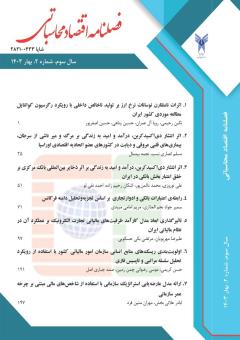اولویتبندی ریسکهای منابع انسانی سازمان امور مالیاتی کشور با استفاده از رویکرد تحلیل سلسله مراتبی و تاپسیس فازی
محورهای موضوعی : فصلنامه اقتصاد محاسباتی
حسن کریمی
1
![]() ,
موسی رضوانی چمن زمین
2
,
صمد جباری اصل
3
,
موسی رضوانی چمن زمین
2
,
صمد جباری اصل
3
![]()
1 - دانشجوی دکتری، گروه مدیریت، واحد آستارا، دانشگاه آزاد اسلامی، آستارا، ایران.
2 - استادیار گروه مدیریت، واحد آستارا، دانشگاه آزاد اسلامی، آستارا، ایران.
3 - استادیار گروه مدیریت، واحد آستارا، دانشگاه آزاد اسلامی، آستارا، ایران.
کلید واژه: تاپسیس فازی, تحلیل سلسله مراتبی, ریسک, سازمان مالیات, منابع انسانی.,
چکیده مقاله :
هدف پژوهش حاضر اولویتبندی ریسکهای منابع انسانی سازمان امور مالیاتی کشور با توجه به معیارهای منتخب است تا سازمان آمادگی لازم را جهت مدیریت و مواجهه با هر یک از این ریسکها داشته باشد. پژوهش حاضر، از نظر هدف کاربردی و ازنظر روش کمی و ابزار مورداستفاده برای جمعآوری دادهها مصاحبه و پرسشنامه است. ابتدا ریسکهای منابع انسانی بر اساس تحقیقات و ادبیات نظری پژوهش شناسایی گردید و در ادامه معیارهای ارزیابی ریسکها با مشارکت 18 نفر از خبرگان، مدیران و کارشناسان سازمان از طریق مصاحبه معین گردید، پس از آن با استفاده از پرسشنامه و فن تحلیل سلسله مراتبی که در میان 60 نفر از کارشناسان، توزیع گردید، وزن معیارها مشخص و در آخر، با بهره بردن از ابزار پرسشنامه و بهکارگیری فن و نرمافزار تاپسیس فازی مورد تجزیهوتحلیل و سنجش قرار گرفتند. یافتهها نشان داد از میان 21 ریسک شناساییشده در سازمان امور مالیاتی کشور ریسک شناسایی و ثبتنام مؤدیان مالیاتی، ریسک نداشتن مهارت ادراکی، ریسک تشخیص و قطعیت مالیات، ریسک عدم برنامهریزی اثربخش، ریسک نداشتن مهارت فنی به ترتیب بیشترین شاخص شباهت به ایدهآل را دارا بوده و پنج اولویت ااول ریسکهای منابع انسانی در سازمان امور مالیاتی کشور است و ریسک عدم رعایت قوانین و مقررات با کمترین شاخص شباهت در اولویت آخر قرار دارد.
Extended Abstract Purpose Risk management is the process of identifying, analyzing and accepting uncertainty in important economic decisions. Usually, risk management occurs when economic managers analyze the possibility of losses and risks of a macroeconomic issue and try to take appropriate measures according to the goals of the organization and the ability to bear risks. Also, risk can be measured both in absolute and relative terms. A complete and correct understanding of different types of risk can help senior economic managers to evaluate opportunities and costs related to the organization's approaches. In fact, human resource risk management by determining, analyzing and applying the necessary measures is known as a valid guarantee for the sustainable and continuous growth of the organization. Identifying, analyzing, measuring human resource risks and adopting strategies to face risks are the main stages of the human resources risk management process. The aim of this study is to prioritize the risks of human resources of the country's tax affairs organization according to the selected criteria so that the organization has the necessary preparation to manage and face each of these risks. Methodology This study is developmental-applicative because it aims to prioritize the risks of human resources in the country's tax affairs organization, and this can be effective in understanding the nature and effects of these risks and their effective management, and in addition, it will expand the literature. In terms of the approach, according to the nature of the data and the use of numbers and figures, it is quantitative research, and from the point of view of the location of the research, it is a library and field research, and interviews and questionnaires have been used as data collection tools. The research has three stages, which are: - The first stage of identifying human resources risks, - The second step is determining the criteria and criteria for ranking human resources risks. The third step is the analysis and evaluation of the organization's human resources risks. Finding The risk of identifying and registering taxpayers with a similarity index of 0.58 is the first priority of the organization that should be taken into account, the statistics published by the authorities of the Tax Affairs Organization regarding tax evasion show this risk. The risk of the passive nature of the human resource deputy with a similarity index of 0.57 is the second priority of the organization, despite the fact that many human resource management processes including recruitment, development, evaluation, etc. are directly related to the organization's resource development deputy, but the management and resource development deputy plays the least role in It has its own field of work, which is certainly one of the important reasons for the politicization of human resource strategies and the political approach of public administration. The third priority of the organization is the risk of tax recognition and certainty with a similarity index of 0.55, which refers to unrealistic tax recognition and certainty, the risk of non-alignment of managers' goals with the goals of the organization with a similarity index of 0.54, the fourth priority of the organization and the risk of not having technical skills with a similarity index of 0.53, the fifth risk in There is a tax agency. Conclusion Human resources, while having an important and essential role in realizing the organizational goals of organizations, can also be a source of dangers and risks. Human resource risks are one of the most important organizational risks. The management of these risks in organizations that have more human resources and have a lot of freedom of action and authority and whose activities are complex and have a wide thematic and geographical scope of activity is necessary and doubly important, because identifying, analyzing and measuring the risks of human resources and In addition to strengthening and facilitating the realization of organizational goals, making policies to deal with them also increases the efficiency of human resources.


